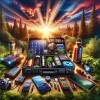
In today's hyper-connected world, the thought of disconnecting might feel both liberating and terrifying. As more adventurers seek solace in the wild, far from Wi-Fi signals and bustling city sounds, one crucial element often gets overlooked: a tech survival kit. While the idea of a tech kit might seem counterintuitive when aiming to unplug, it can be the difference between a memorable adventure and a distressing ordeal. Let's delve into why a tech survival kit is indispensable for your off-the-grid excursions.
Understanding the Basics of a Tech Survival Kit
Imagine you're deep in the woods, miles away from civilization, and your phone’s battery is on its last leg. A tech survival kit is essentially a collection of devices and tools designed to support you in such scenarios. Think of it as a safety net, not just for emergencies, but also for enhancing your overall experience. At its core, a tech survival kit includes a reliable power source, navigation aids, and communication devices. While these might sound like the basics, each component plays a pivotal role in ensuring your safety and comfort.
Power Up: Portable Chargers and Solar Panels
One of the most common blunders outdoor enthusiasts make is underestimating their power needs. A portable charger is a non-negotiable item in any tech kit. Opt for a high-capacity power bank that can recharge your devices multiple times. But, let's not stop there. Incorporate a solar panel charger as well. These are lightweight, foldable, and can harness the sun's power to keep your gadgets juiced up. Remember, the sun is your ally, especially during extended trips. A common mistake is relying solely on battery packs without a renewable option. Solar panels offer a sustainable solution, ensuring your devices remain operational throughout your journey.
Navigation Tools: More than Just a Compass
While a traditional compass is invaluable, today's digital tools can enhance your navigation capabilities. A GPS device designed for rugged terrains can provide real-time location data and help you track your route. Additionally, downloading offline maps on your smartphone ensures you have a backup even when network signals fade. Apps like Gaia GPS or AllTrails are popular choices among hikers. However, don't fall into the trap of over-relying on these tools. Always carry a physical map as a backup. The digital world is fantastic, but it’s not infallible.
Communication: Staying Connected in Isolation
Even in the most remote locations, staying connected with the outside world is crucial. Satellite phones and personal locator beacons (PLBs) are essential for emergency communication. Unlike regular phones, satellite devices can send signals from virtually anywhere on the planet. A PLB can be a lifesaver, sending your exact location to rescue services at the push of a button. While these devices might seem like overkill, they provide peace of mind. A common oversight is relying solely on mobile networks, which can be spotty or non-existent in remote areas.
Lighting the Way: Portable Lights and Headlamps
The wilderness transforms at night, and having reliable lighting is imperative. A sturdy flashlight and a headlamp are must-haves in any tech survival kit. Opt for LED options as they provide brighter light and consume less power. Rechargeable models are preferred, ensuring you can power them up using your portable chargers. While it might seem trivial, lighting can significantly impact your safety and ability to navigate in the dark. A frequent mistake is packing just one light source. Always have a backup; you never know when you'll need it.
Weather Monitoring: Be Prepared for Nature’s Whims
Weather can be unpredictable, especially in mountainous or forested areas. A compact weather radio can keep you informed of any sudden changes. Modern models often come with alerts for severe weather conditions, providing you with ample time to find shelter. Alternatively, consider apps that offer offline weather forecasts. However, ensure your devices are always charged and ready. The biggest blunder is ignoring weather forecasts altogether, which can lead to dangerous situations.
Capturing Memories: Cameras and Drones
While the primary goal of an off-the-grid trip is to immerse yourself in nature, capturing memories is equally important. A durable camera or a drone can record breathtaking views and moments. Opt for devices that are water-resistant and have long battery life. While smartphones are handy, they might not offer the same quality or resilience. Remember to pack extra batteries or a charger specifically for your camera gear. Don’t fall into the trap of carrying excessive equipment; prioritize quality over quantity.
Emergency Preparedness: First Aid Apps and Tools
Accidents can happen, even to the most seasoned adventurers. Having a digital first aid guide on your phone or a dedicated app can be invaluable. These resources offer step-by-step instructions for handling common injuries. Additionally, a compact first aid kit with essential supplies is non-negotiable. While tech can guide you, it can’t replace the physical tools needed for immediate care. A common error is neglecting this aspect, assuming the wilderness is forgiving. Always be prepared for the unexpected.
The Role of Entertainment: E-Readers and Music
While the sounds of nature are soothing, sometimes a little entertainment can enhance your experience. An e-reader loaded with books or a music player can provide relaxation during downtime. Opt for devices with extended battery life, ensuring they don’t drain your power reserves. While this might seem like a luxury, mental well-being is just as crucial as physical safety. However, balance is key; don’t let technology overshadow the natural beauty surrounding you.
Avoiding Common Mistakes: Planning and Packing Tips
Preparation is paramount. Before setting off, test all your devices to ensure they’re in working order. Organize your tech gear, making it easily accessible in your backpack. Avoid overloading; prioritize essentials based on the trip’s duration and location. A common mistake is packing without a checklist, leading to forgotten items or unnecessary weight. Remember, the goal is to enhance your adventure, not burden it with excessive gear.






























